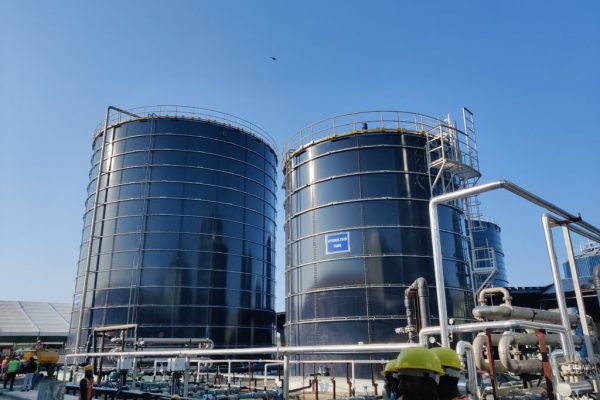Project Report For Bio CNG Plant
Introduction
The project report for Bio CNG Plant is as follows.
A gas that is naturally created by the anaerobic decomposition of biomass such as agricultural waste, animal droppings, leftovers from agro-food industries, home trash, and so on. As we all know, Bio-CNG is purified. The principal elements are methane, carbon dioxide, and traces of other gases such as water vapor, oxygen, hydrocarbons, ammonia, and so on. It is a highly combustible gaseous fuel that emits heat and energy. Biogas is inappropriate for use as a fuel due to elements such as water vapor, hydrogen sulfide, and carbon dioxide. Before being compressed into Compressed Bio Gas, biogas is filtered to remove hydrogen sulphide, carbon dioxide, and water vapor.
Bio-CNG is a purified and compressed form of biogas that contains more than 90% methane. Purification of biogas is required to maximise its energy potential. It is a clean renewable fuel with similar calorific value and other qualities to CNG. As a result, Bio-CNG (CBG) can replace CNG in industries, autos, and residential and commercial applications.
Bio-CNG is produced from biogas through a straightforward and convenient process that comprises desulphurization, upgrading, and compression. If the biogas contains more than 1,500 ppm of hydrogen sulphide, it is desulphurised first. The desulphurized biogas is then enhanced to have a similar composition to CNG, and the resulting bio-CNG is compressed and bottled.
Bio-CNG is composed of 92-98 percent methane and just 2-8 percent carbon dioxide, whereas biogas is composed of 55-65 percent methane and 35-45 percent carbon dioxide. The calorific value of bio-CNG is around 52,000 kilojoules (kJ) per kilogram, which is nearly 167 percent greater than the calorific value of biogas, which is 19,500 kJ per kg.
Bio-CNG is a great fuel for automobiles and power generation due to its high methane content and calorific value, as well as its low moisture, sulphide of hydrogen, and contaminants. Bio-CNG is also a more environmentally friendly fuel than biogas due to its low emission levels.
Benefits Or Advantages Of Bio-CNG Plant
- It has a high calorific value.
- It is an environmentally friendly fuel. It contributes to the reduction of air pollution.
- It leaves no residue behind.
- It doesn’t release any smoke.
- It does not pollute the environment.
- It is very cost-effective.
- It lessens the strain on trees and fossil fuels.
- It is easily delivered to houses via pipelines, as shown.
- It has a convenient ignition temperature and is hence easy to burn.
- It is less expensive than traditional fuels.
- It is comparable to natural gas in composition and properties.
- More bio-mass availability will result in the increased generation of bio-CNG.
- It can help to avoid problems caused by solid waste disposed of in landfills.

Drawbacks Or Disadvantages Of Bio-CNG Plant
- Using bio-CNG without sufficient purification might cause metal parts in automobiles to corrode.
- Using software and data analytic techniques, the purity of bio-CNG reserves may be tracked. This raises the cost.
- The global adoption of bio-CNG is influenced by a variety of economic, environmental, and technical variables.
- The capital cost of installing bio-CNG facilities is significant.
- The sources of feed ingredients are inconsistent.
- Because high pressure is necessary for specific components, refuelling stations are more difficult than normal ones.
- Because of the limited driving range, extra fuel cylinders may be required to extend the range.
- There is a scarcity of skilled workers in this domain for the production process.
- Many countries lack suitable norms and rules for installation and operation/maintenance.
Market Potential Of Bio CNG Plant
The India biogas industry is expected to be worth USD 1.40 billion in 2021. The market is expected to grow at a 6.3% CAGR between 2022 and 2029, rising from USD 1.47 billion in 2022 to USD 2.25 billion in 2029.
The market is segmented into organic residue & trash and energy crops based on the feedstock. Animal waste, municipal and sewage waste, agricultural waste, and other organic leftovers and wastes are further categorized.
In India, bio-CNG has immense potential, notably as a replacement for CNG and liquefied petroleum gas (LPG), which are currently in use. Furthermore, bio-CNG has commercial (hotels, canteens, bakeries, and resorts) and industrial (glass and ceramic, metal processing, cement, and textiles) applications, as well as automotive (public transportation and private cars and trucks).
India produces about 350 million tonnes of agricultural waste each year, which may create more than 18,000 MW of power and green fertilizer for agricultural use. India creates approximately 0.1 million tonnes of municipal solid garbage every day. This amounts to around 36.5 million tonnes per year. Garbage generation per capita in large Indian cities is between 0.2 and 0.6 kilograms. Solid waste management costs urban local governments between Rs.500 and Rs.1500 per tonne.
India’s biogas potential is enormous. More than 5 million biogas units are currently active throughout the country. The biggest biogas plant operating states in India include Maharashtra, Gujarat, Karnataka, Uttar Pradesh, and Madhya Pradesh. By the end of 2020, Maharashtra will have the most biogas plants, with 925,235. With the assistance of MNRE, the Union Ministry stated its desire to develop at least 5,000 bio-CNG-producing facilities in India.
In addition, the Ministry of New and Renewable Energy (MNRE) has given Concessional Custom Duty Certificates (CCDC) for the import of machinery and components. These machines and components are required for the initial setup of projects that generate power from non-traditional materials such as agricultural, forestry, agro-industrial, industrial, municipal, and urban waste, bio waste, or poultry litter.
Project Report Sample On
Bio CNG Plant
Need Help?
Create 100% Bankable Project Report

